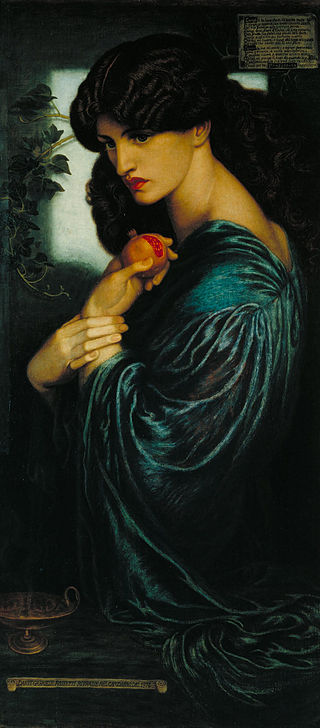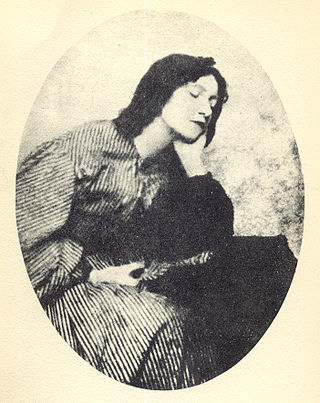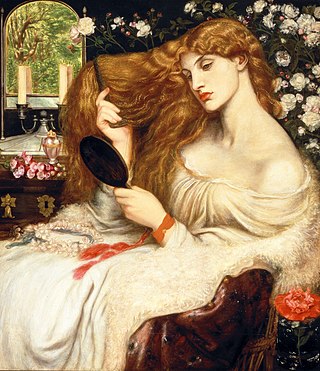
The Pre-Raphaelite Brotherhood was a group of English painters, poets, and art critics, founded in 1848 by William Holman Hunt, John Everett Millais, Dante Gabriel Rossetti, William Michael Rossetti, James Collinson, Frederic George Stephens and Thomas Woolner who formed a seven-member "Brotherhood" modelled in part on the Nazarene movement. The Brotherhood was only ever a loose association and their principles were shared by other artists of the time, including Ford Madox Brown, Arthur Hughes and Marie Spartali Stillman. Later followers of the principles of the Brotherhood included Edward Burne-Jones, William Morris and John William Waterhouse.

Gabriel Charles Dante Rossetti, generally known as Dante Gabriel Rossetti, was an English poet, illustrator, painter, translator and member of the Rossetti family. He founded the Pre-Raphaelite Brotherhood in 1848 with William Holman Hunt and John Everett Millais. Rossetti inspired the next generation of artists and writers, William Morris and Edward Burne-Jones in particular. His work also influenced the European Symbolists and was a major precursor of the Aesthetic movement.

Elizabeth Eleanor Siddall, better known as Elizabeth Siddal, was an English artist, artists' model, and poet. Siddal was perhaps the most significant of the female models who posed for the Pre-Raphaelite Brotherhood. Their ideas of female beauty were fundamentally influenced by her, or that she personified these ideals. Walter Deverell, William Holman Hunt, and John Everett Millais all painted Siddal, and she was the model for Millais' famous painting Ophelia (1852). Early in her relationship with Dante Gabriel Rossetti, Siddal became his muse and exclusive model, and he portrayed her in almost all his early artwork depicting women. Siddal became an artist in her own right and was the only woman to exhibit at a 1857 Pre-Raphaelite exhibition. Significant collections of her artworks can be found at Wightwick Manor and the Ashmolean. Sickly and melancholic during the last decade of her life, Siddal died of a laudanum overdose in February 1862 during her second year of marriage to Rossetti.

Kelmscott Manor is a limestone manor house in the Cotswolds village of Kelmscott, in West Oxfordshire, southern England. It dates from around 1570, with a late 17th-century wing, and is listed Grade I on the National Heritage List for England. It is situated close to the River Thames. The nearest town is Lechlade-On-Thames.

Jane Morris was an English embroiderer in the Arts and Crafts movement and artists' model who embodied the Pre-Raphaelite ideal of beauty. She was a model and muse to her husband William Morris and to Dante Gabriel Rossetti. Her sister was embroiderer and teacher Elizabeth Burden.

Fanny Cornforth was an English artist's model, and the mistress and muse of the Pre-Raphaelite painter Dante Gabriel Rossetti. Cornforth performed the duties of housekeeper for Rossetti. In Rossetti's paintings, the figures modelled by Fanny Cornforth are generally rather voluptuous, differing from those of other models such as Jane Morris and Elizabeth Siddal.

A Vision of Fiammetta is an oil painting created by Dante Gabriel Rossetti, in the Pre-Raphaelite style, created in 1878. The painting was one half of one of Rossetti's "double works", accompanying his Ballads and Sonnets (1881). Maria Spartali Stillman modelled for the painting. The subject of painting is Boccaccio's muse named Fiammetta.

"The Blessed Damozel" is perhaps the best known poem by Dante Gabriel Rossetti, as well as the title of his painting illustrating the subject. The poem was first published in 1850 in the Pre-Raphaelite journal The Germ. Rossetti subsequently revised the poem twice and republished it in 1856, 1870 and 1873.

Dante's Dream is a painting from 1871 by the English Pre-Raphaelite painter Dante Gabriel Rossetti. It hangs in the Walker Art Gallery, Liverpool.

Lady Lilith is an oil painting by Dante Gabriel Rossetti first painted in 1866–1868 using his mistress Fanny Cornforth as the model, then altered in 1872–73 to show the face of Alexa Wilding. The subject is Lilith, who was, according to ancient Judaic myth, "the first wife of Adam" and is associated with the seduction of men and the murder of children. She is shown as a "powerful and evil temptress" and as "an iconic, Amazon-like female with long, flowing hair."

Found is an unfinished oil painting by Dante Gabriel Rossetti, now in the Delaware Art Museum. The painting is Rossetti's only treatment in oil of a contemporary moral subject, urban prostitution, and although the work remained incomplete at Rossetti's death in 1882, he always considered it one of his most important works, returning to it many times from the mid-1850s until the year before his death.

Ecce Ancilla Domini, or The Annunciation, is an oil painting by the English artist Dante Gabriel Rossetti, first painted in 1850 and now in Tate Britain in London. The Latin title is a quotation from the Vulgate text of the first chapter of the Gospel of Saint Luke, describing the Annunciation, where Mary accepts the message brought to her by the Angel Gabriel that she would give birth to a child (Jesus) by God.

Pia de' Tolomei is an oil painting on canvas by English artist Dante Gabriel Rossetti, painted around 1868 and now in the Spencer Museum of Art, on the campus of the University of Kansas in Lawrence, Kansas.

Proserpine is an oil painting on canvas by English artist and poet Dante Gabriel Rossetti, painted in 1874 and now in Tate Britain. Rossetti began work on the painting in 1871 and painted at least eight separate versions, the last only completed in 1882, the year of his death. Early versions were promised to Charles Augustus Howell. The painting discussed in this article is the so-called seventh version commissioned by Frederick Richards Leyland, now at the Tate Gallery, with the very similar final version now at the Birmingham Museum and Art Gallery.

Paolo and Francesca da Rimini is a watercolour by British artist and poet Dante Gabriel Rossetti, painted in 1855 and now in Tate Britain.

Love and the Maiden is an oil painting on canvas by English Pre-Raphaelite artist John Roddam Spencer Stanhope that is currently housed at the Fine Arts Museums of San Francisco.

Mnemosyne, also titled Lamp of Memory and Ricordanza, is an oil painting by Dante Gabriel Rossetti begun in 1875 or early 1876 and completed in 1881. Jane Morris was the model, and Frederick Richards Leyland bought the painting in 1881 and displayed it in his drawing room with five other Rossetti "stunners." At about the same time Rossetti, a founder of the Pre-Raphaelite Brotherhood, was painting Astarte Syriaca, a larger painting completed in 1877 with Morris in a very similar pose.

Veronica Veronese is an oil painting by Dante Gabriel Rossetti painted in 1872 with Alexa Wilding as the model. The painting was conceived as a companion to Lady Lilith. Rossetti sold the painting to one of his best clients, shipping magnate Frederick Richards Leyland. In 1923 it was acquired by the estate of Samuel Bancroft which donated it in 1935 to the Delaware Art Museum.

Monna Rosa is the title of two oil paintings by Dante Gabriel Rossetti, both portraits of Frances Leyland, the wife of shipping magnate Frederick Richards Leyland, a regular patron of Rossetti. The earlier and smaller painting was completed in 1862 and its whereabouts is now unknown. The second was completed in 1867 and is now in a private collection.

John Robert Parsons was an Irish photographer and painter. He is best known by the series of photographs he made in 1865 by Dante Gabriel Rossetti's model Jane Morris.




















